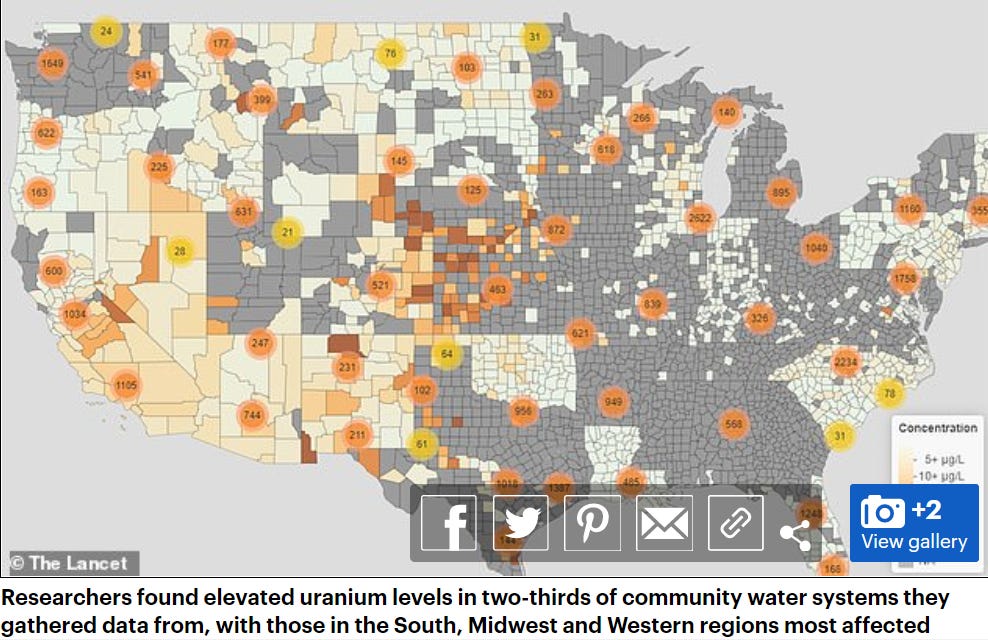Unsafe levels of URANIUM have been detected in two-thirds of public drinking water in the US with those in the Midwest and South most at-risk
Data from the Environmental Protection Agency (EPA) shows that drinking water in some parts of America may contain unsafe levels of uranium.
By Mansur Shaheen - @DailyMail
7 April 2022
Researchers at Columbia University found that two-thirds of US drinking water systems have elevated levels of uranium
Around 90% of Americans use community drinking water systems, making this a wide-reaching problem in the U.S.
Hypertension, cardiovascular disease, kidney damage, and lung cancer have all been tied to uranium exposure
Elevated levels of arsenic, barium, chromium, selenium were found in many drinking water systems around the country as well
Data from the Environmental Protection Agency (EPA) shows that drinking water in some parts of America may contain unsafe levels of uranium.
Researchers from Columbia University analyzed nationwide data, and compared it to safety standards laid out by the EPA.
They found that many localities in the south and Midwest in particular had unsafe levels of uranium detected in water.
While small amounts of many chemicals are acceptable in water, according to safety standards, consistent exposure to it in drinking water can cause a long list of deadly and debilitating diseases.
Contaminated water has become a rising issue in America off of the back of the flint water crisis, an increased attention has been paid to contamination of lead and other metals in U.S. drinking water - which is more common than many may believe.
Researchers, who published their findings at the start of the month in The Lancet Planetary Healthy, gathered data from 2000-2011 for the study, reviewing recorded metal levels from nearly 38,000 sites.
Levels of antimony, arsenic, barium, beryllium, cadmium, chromium, mercury, selenium, thallium, and uranium were studied.
They found elevated levels of uranium across the country, with researchers nothing that semi-urban and Hispanic communities were most at risk of being exposed to the contaminated water.
In total, nearly two-thirds of sites tested had some sort of uranium contamination.
Counties across the Midwest, West coast and southern regions of the country were most affected.
Some counties across Kansas and Nebraska in particular were displaying the highest levels of uranium.
Many Americans may not think that uranium poisoning is a thing to worry about in their day-to-day life, and may not even be aware that it can be found in their drinking water.
'Uranium is an under-recognized contaminant in [community water systems],' the researchers wrote in the study.
The research presents grave implications for the health of Americans, as the problem is wide reaching and can have disastrous health effects in the future.
'Previous studies have found associations between chronic uranium exposure and increased risk of hypertension, cardiovascular disease, kidney damage, and lung cancer at high levels of exposure,' Dr Anne Nigra, an assistant professor of environmental health at Columbia University wrote in a release.
The release points out that 90 percent of Americans rely of a public drinking water system of some kinds, making contaminated water at this scale an issue that touches nearly every American.
Researchers are calling for further investment and regulation to prevent suffering from uranium exposure.
'Additional regulatory policies, compliance enforcement, and improved infrastructure are therefore necessary to reduce disparities in CWS metal concentrations and protect communities served by public water systems with elevated metal concentrations,' Nigra said.
'Such interventions and policies should specifically protect the most highly exposed communities to advance environmental justice and protect public health.'
Elevated levels of arsenic, barium, chromium, selenium were found in community drinking water as well, though not to the same extent as uranium.
If you appreciate our content, please consider making a donation -- GiveSendGo - Help Support Tuzara Post Newsletter





